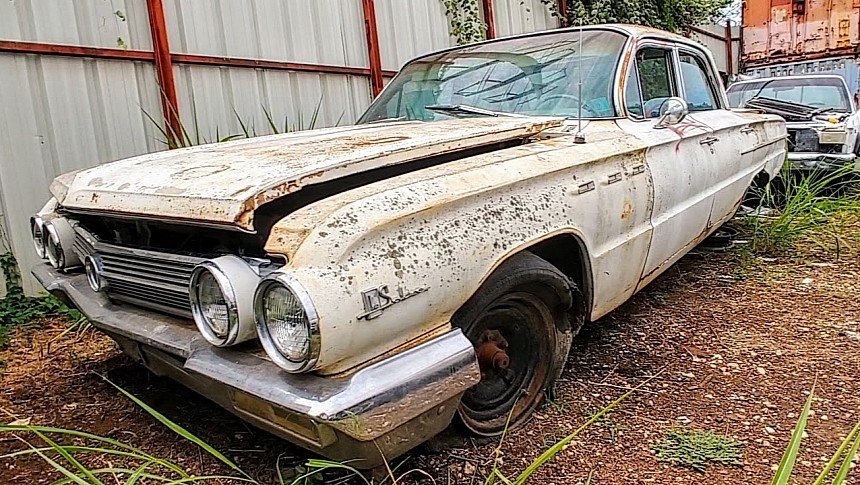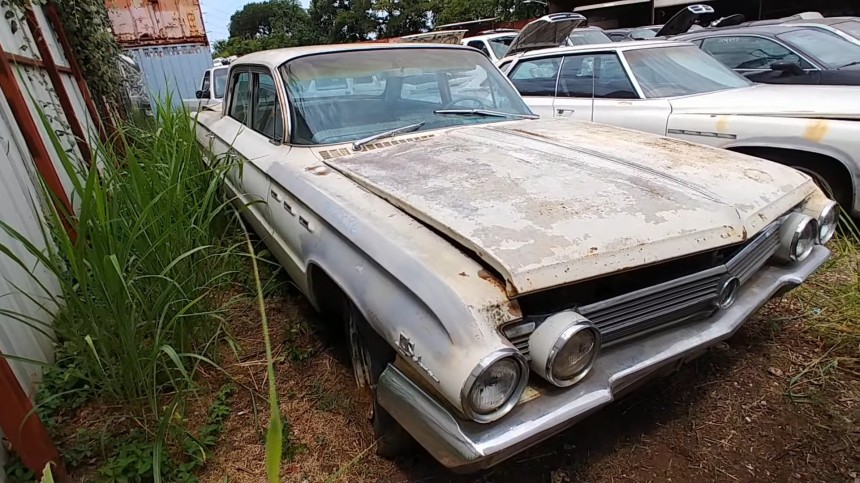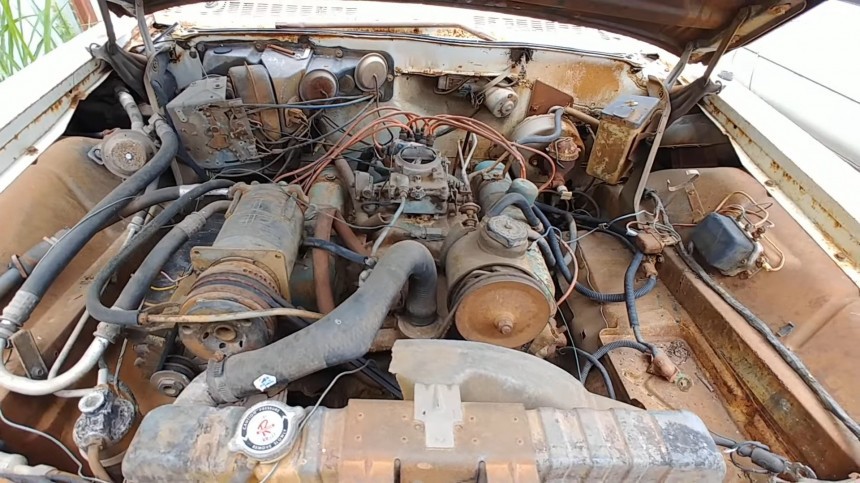In 1951, after the ashes of the war had not only settled down but were also blown away by the sweeping currents of economic recovery, Harley Ears – GM’s chief stylist – brought back the concept of ‘concept car’ with the GM LeSabre. Eight years later, Buick adopted the name for its new line of automobiles, but the mass-produced moniker had little to do with the jet-age-inspired concept. Even without the fuss and thrills, the LeSabre stood tall for nearly half a century.
As the fifties drew to a close, the fins on the rear fenders of American cars began to shrink. Eventually, they dissolved into the streamlined tendencies of the space race decade. The boisterous, shiny, ornament-clad, and chrome-rich styling relented to more composed lines, discrete tenure, and straight-edged, flat-surfaced designs. It was as if, almost overnight, Detroit had decided it was time to let go of the past and emphasize other traits of the automobile.
Mind you, the horsepower wars were well underway by that time. The muscle car idea was not even a seed in the mind of Pontiac’s larger-than-life engineers, John Zachary DeLorean, Bill Collins, and Rus Gee. GM hadn’t yet levied the displacement-axing edict that capped the engine choices, so everything was fine still in this aspect.
The first generation of the Buick LeSabre lasted for just two model years, between 1959 and 1960. Still, all the subsequent seven generations spanned at least five years each. Paving the way for what would eventually lead to the box-bodied automobiles of the eighties, the early sixties dropped curvaceous profiles in favor of gradually squarer looks. The LeSabre didn’t make an exception and shed the first-gen apparel of the late fifties for a more youthful appearance.
The model's second generation was considerably toned down regarding looks, so it played the technical specs card to attract buyers. Buick engineers decided everyone else was wrong with placing the engine behind the front axle. Instead, the wrench-turning hobbits at the GM division praised the advantages of pushing the driveline – engine, and transmission – as far forward as mechanically possible.
They called it ‘Advanced Thrust’ and advocated its advantages when driving against strong side winds (for some uncertain reason) on the newly-built (at the time) highways. There was one undeniable argument in favor of the engine-over-the steering-wheels architecture: the transmission tunnel diminished to a mere hump in the floor. The unseen secret of this magic trick was that the driveshaft went through the frame – Buick called it the Equipoise chassis.
The LeSabre of 1962 came in four body styles – two and four-door sedans, a four-door hardtop, and a two-door sport coupe (a two-door hardtop). The four-door post sedan was the best-seller for the year, at almost 57,000 units. It's not rare but not ubiquitous, making finding one (regardless of condition) a nice bonus for gearheads.
While some are in pristine condition – be it pampered original or painstakingly restored – others didn’t have the same fate. Take this junkyard example, discovered by the Classic Ride Society YouTube Channel. Last seen on the road 40 years ago, this plain-Jane 1962 Buick LeSabre four-door looks battered but not fatally mauled.
The trunk floor is not anymore – a telltale sign of Florida’s oceanic atmosphere – but the car can still make for a suitable donor, with body panels, engine, glass, and some trim in good condition. The interior is deteriorated, save for the headliner. Also, the rear bench drastically contrasts with the front one – the latter is eaten to the wireframing on the driver’s side.
Also, the dash padding is gone – either someone salvaged it, or it was uselessly and hopelessly gone, and it was removed – but the instruments cluster and dash don’t look all that disappointing. The car was assembled in Arlington, Texas, on the first week of October 1961. Whoever ordered this new car didn’t have a shallow pocket, ticking the air conditioning, power steering, power brakes, and other creature comfort boxes, like a right-hand mirror, a tissue dispenser, and a litter basket).
In 1962, the LeSabre – along with all full-size Buicks – came with a 401-cubic-inch V8 (the 6.6-liter Nailhead) that was, somewhat confusing, named by its torque output. The engine was the ‘Wildcat’ – which, in 1962, was also a subseries of the Invicta line – and it came in three performance ratings - all mated to a single-speed torque-converter automatic gearbox. The second video is a bitter review of the infamous one-speed Turbine-Drive transmission, so 'performance' might not be the most suitable adjective.
The standard for the LeSabre was the two-barrel Wildcat 410, with – somewhat counterintuitively – 424 lb-ft and 280 hp (575 lb-ft, 284 PS) thanks to its 10.25:1 compression ratio. Optional was the Wildcat 375, which offered 412 lb-ft and 265 hp (559 Nm, 269 PS) due to a regular-gas-friendly 9.0:1 compression. It was available as a no-cost option, unlike the beefy Wildcat 445. With a lone four-barrel carburetor and high compression (10.25:1), this engine produced what it said: 445 1lb-ft and 325 hp (603 Nm, 330 hp).
The discrepancies in the torque ratings and engine names were due to the history of the powerplant. Initially a 364-cubic-inch V8 (6.0-liter), the engine bored out and stroked to achieve the 401 incher status. The original Wildcat produced the torque numbers it proudly displayed on its air cleaner lid. The naming policy was maintained after the displacement augmentation for marketing purposes, although the actual specs varied.
Mind you, the horsepower wars were well underway by that time. The muscle car idea was not even a seed in the mind of Pontiac’s larger-than-life engineers, John Zachary DeLorean, Bill Collins, and Rus Gee. GM hadn’t yet levied the displacement-axing edict that capped the engine choices, so everything was fine still in this aspect.
The first generation of the Buick LeSabre lasted for just two model years, between 1959 and 1960. Still, all the subsequent seven generations spanned at least five years each. Paving the way for what would eventually lead to the box-bodied automobiles of the eighties, the early sixties dropped curvaceous profiles in favor of gradually squarer looks. The LeSabre didn’t make an exception and shed the first-gen apparel of the late fifties for a more youthful appearance.
They called it ‘Advanced Thrust’ and advocated its advantages when driving against strong side winds (for some uncertain reason) on the newly-built (at the time) highways. There was one undeniable argument in favor of the engine-over-the steering-wheels architecture: the transmission tunnel diminished to a mere hump in the floor. The unseen secret of this magic trick was that the driveshaft went through the frame – Buick called it the Equipoise chassis.
The LeSabre of 1962 came in four body styles – two and four-door sedans, a four-door hardtop, and a two-door sport coupe (a two-door hardtop). The four-door post sedan was the best-seller for the year, at almost 57,000 units. It's not rare but not ubiquitous, making finding one (regardless of condition) a nice bonus for gearheads.
The trunk floor is not anymore – a telltale sign of Florida’s oceanic atmosphere – but the car can still make for a suitable donor, with body panels, engine, glass, and some trim in good condition. The interior is deteriorated, save for the headliner. Also, the rear bench drastically contrasts with the front one – the latter is eaten to the wireframing on the driver’s side.
Also, the dash padding is gone – either someone salvaged it, or it was uselessly and hopelessly gone, and it was removed – but the instruments cluster and dash don’t look all that disappointing. The car was assembled in Arlington, Texas, on the first week of October 1961. Whoever ordered this new car didn’t have a shallow pocket, ticking the air conditioning, power steering, power brakes, and other creature comfort boxes, like a right-hand mirror, a tissue dispenser, and a litter basket).
The standard for the LeSabre was the two-barrel Wildcat 410, with – somewhat counterintuitively – 424 lb-ft and 280 hp (575 lb-ft, 284 PS) thanks to its 10.25:1 compression ratio. Optional was the Wildcat 375, which offered 412 lb-ft and 265 hp (559 Nm, 269 PS) due to a regular-gas-friendly 9.0:1 compression. It was available as a no-cost option, unlike the beefy Wildcat 445. With a lone four-barrel carburetor and high compression (10.25:1), this engine produced what it said: 445 1lb-ft and 325 hp (603 Nm, 330 hp).
The discrepancies in the torque ratings and engine names were due to the history of the powerplant. Initially a 364-cubic-inch V8 (6.0-liter), the engine bored out and stroked to achieve the 401 incher status. The original Wildcat produced the torque numbers it proudly displayed on its air cleaner lid. The naming policy was maintained after the displacement augmentation for marketing purposes, although the actual specs varied.




































